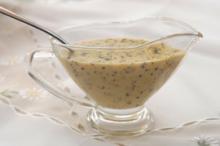Often the difference between "meh" cooking and haute cuisine is a good sauce. Strangely, a lot of people don't know the esoteric but simple techniques behind making a proper sauce. Truly a lot of the preliminary steps seem odd or counter-intuitive, but the magic of food science is part of the fun of cooking. Two ways to go about creating excellent sauce are to create either a fond or a roux.
Roux and fond are good at doing different things, so which method you use all depends on what dish you're making. Roux is good for creating simpler, less potent sauces called "mother sauces" that can be further augmented to make specific sauces while fond is a more ad hoc sauce made from elements of the dish it will be topping.
Roux is created by mixing, by weight, equal parts liquid fat and a dry thickening agent, usually flour. Traditional French dishes as well as many Asian roux variations use clarified butter, though vegetable oil and even rendered bacon fat can be used as well. To make the roux, simply heat the fat in a sauce pan on low to medium-low heat and very gradually incorporate the thickener. The best way to do this is to sift it in while whisking. This keeps the thickener from clumping up early and burning. Depending on the intended sauce the mixture is heated for varying lengths of time. The most important part is making sure the two elements are fully incorporated into a sort of homogeneous paste.
At this point you can add any number of things to the roux to make a sauce. Bechamel sauce is a mixture of roux and scalded milk, serving as the base for any number of creamy sauces like Mornay and Nantua, while darker sauces like Espagnole can be made by adding stock, vegetables and seasoning. From there the sky's the limit for additions and applications for specific sauces.
Fond is a faster, more specific sauce preparation method. Unlike roux, which is made independent of the final dish, fond is prepared through the process of deglazing, which requires some cooking beforehand. When something is fried or roasted in a pan it usually leaves behind bits of caramelized or carbonized matter on the bottom of the pan. While these hard pieces can end up just being a nuisance at cleanup time, they're packed with flavor and potential. Start by taking the pan off the heat temporarily then add a moderate amount of liquid, such as wine, brandy, milk or even water. Use a spatula to scrap the hard bits off the bottom of the pan and then return to the pan to a stove top on medium-low heat. Let the mixture reduce to your desired thickness and season with herbs and spices. If the mixture needs to be thicker you can add flour or cornstarch, though you should be aware that this will add some starchy flavor to the final product. Return the cooked food to the pan or pour the new sauce over the food. Voila, fond-style sauce.
The benefits of fond are that it's fast and uses flavors already present in the final dish so it will taste fitting. It's generally less fussy than roux-based sauce and has a more intense flavor.
Creating sauce at home is easy and it guarantees an extra "wow" factor in your dishes. Once you perfect your roux and fond methods, you'll wonder how you ever cooked without them.
